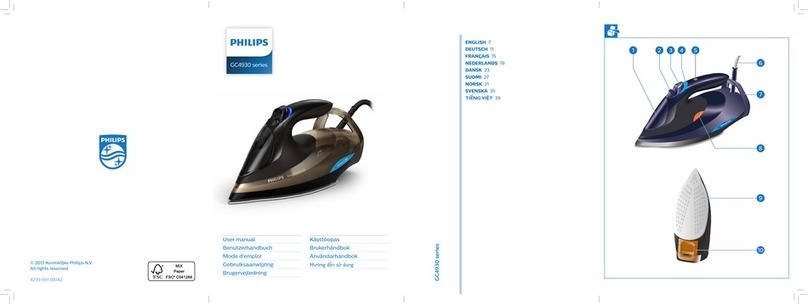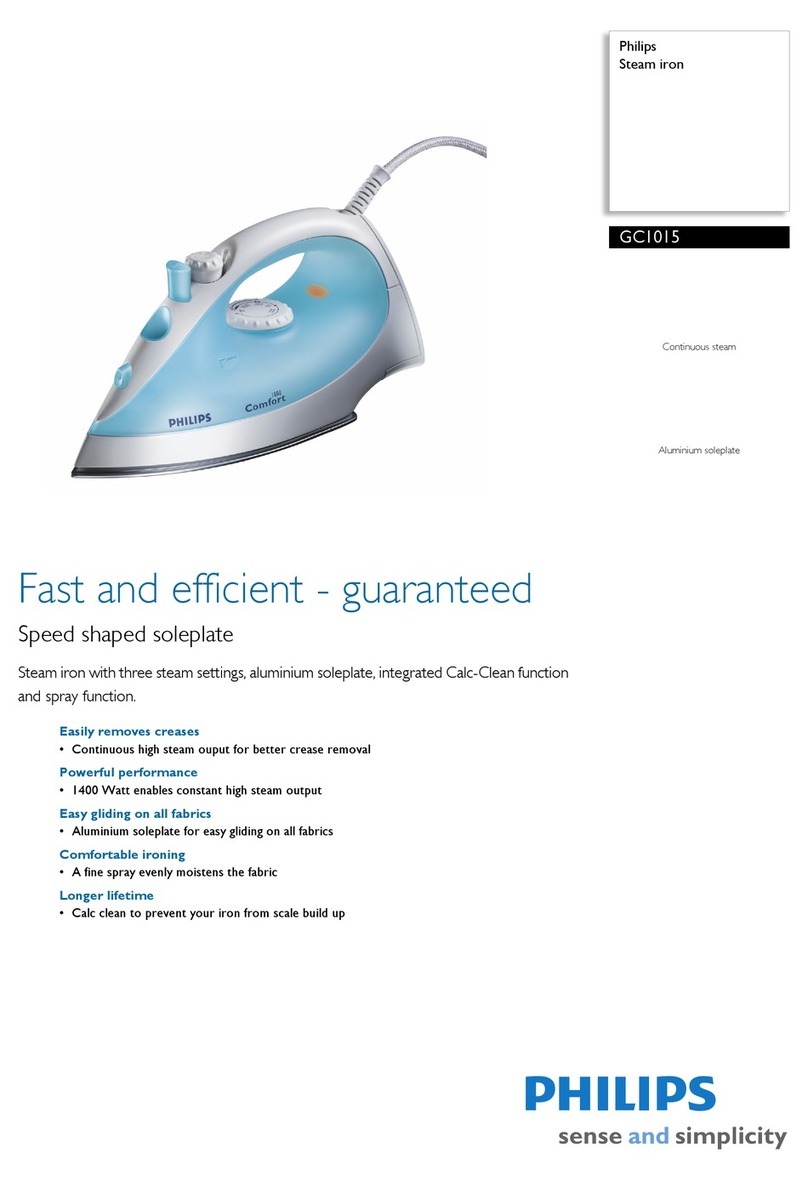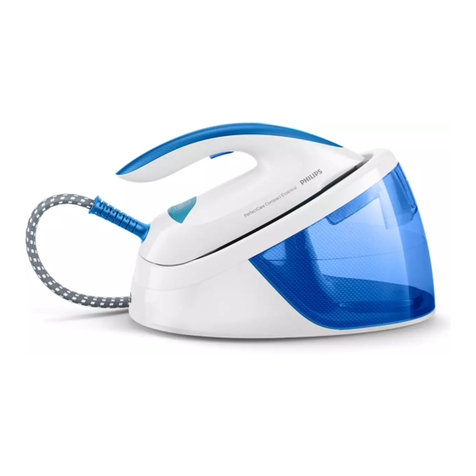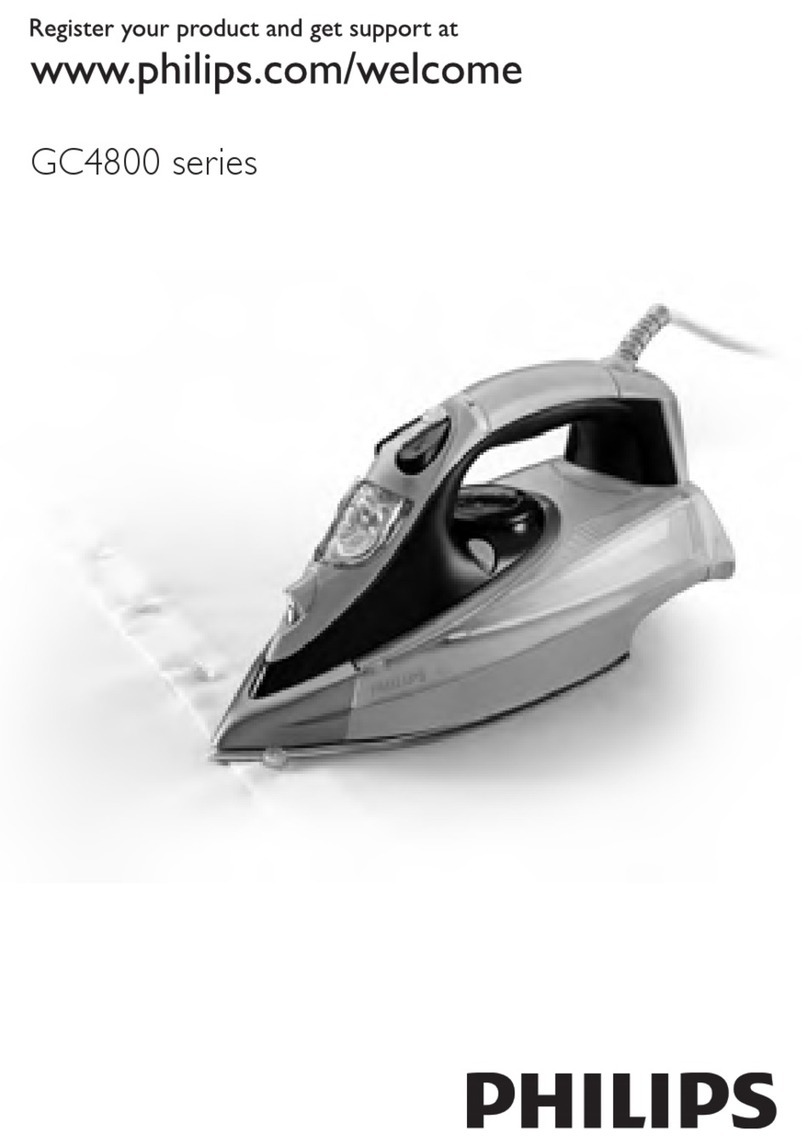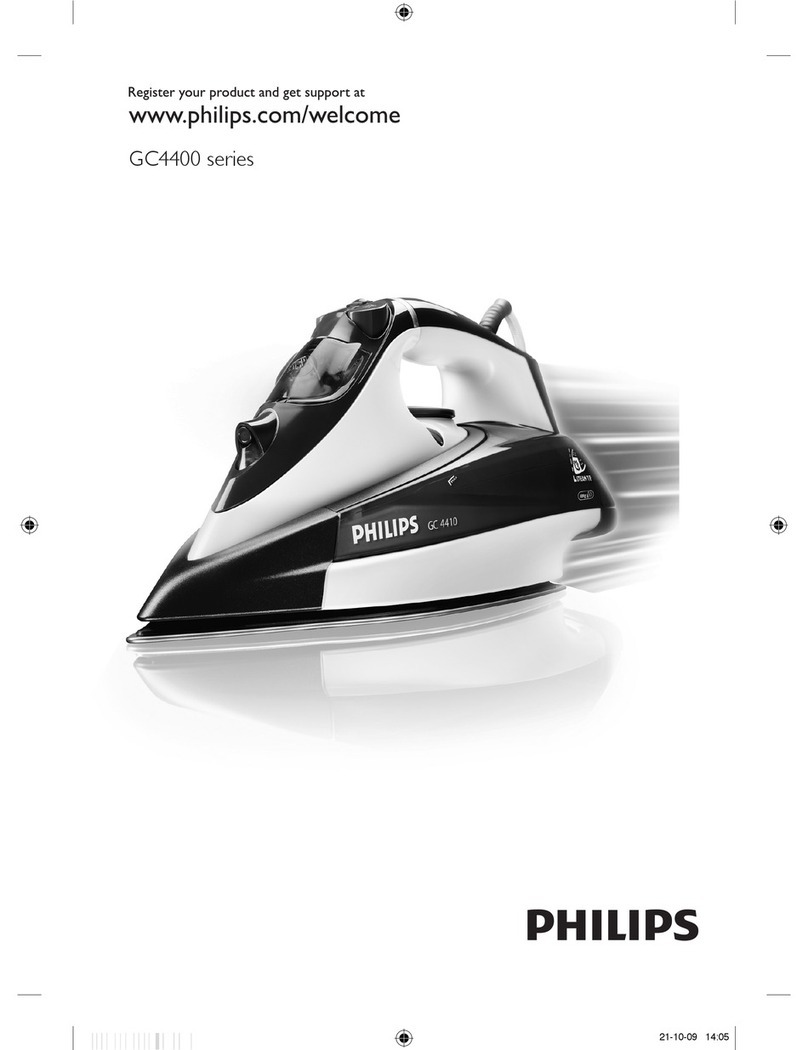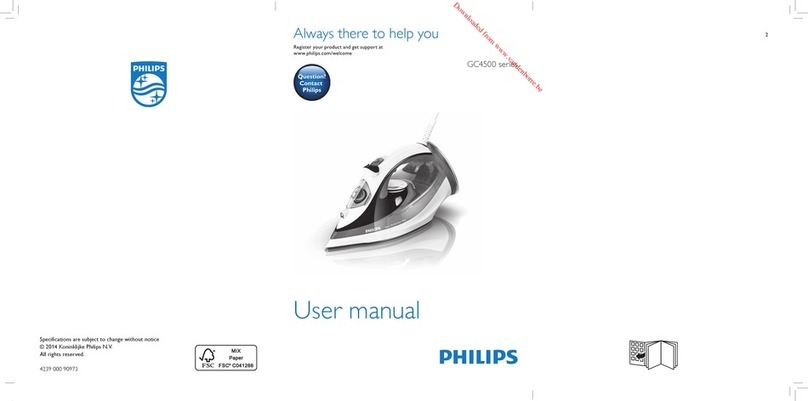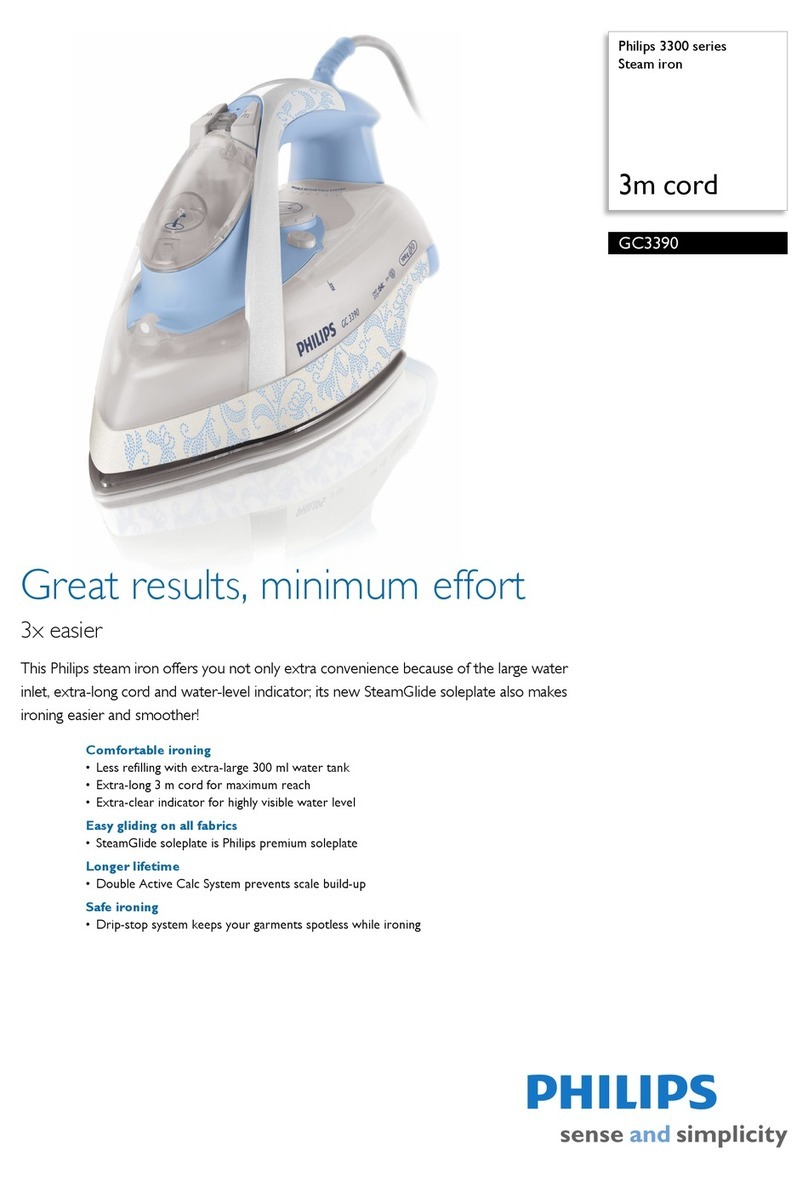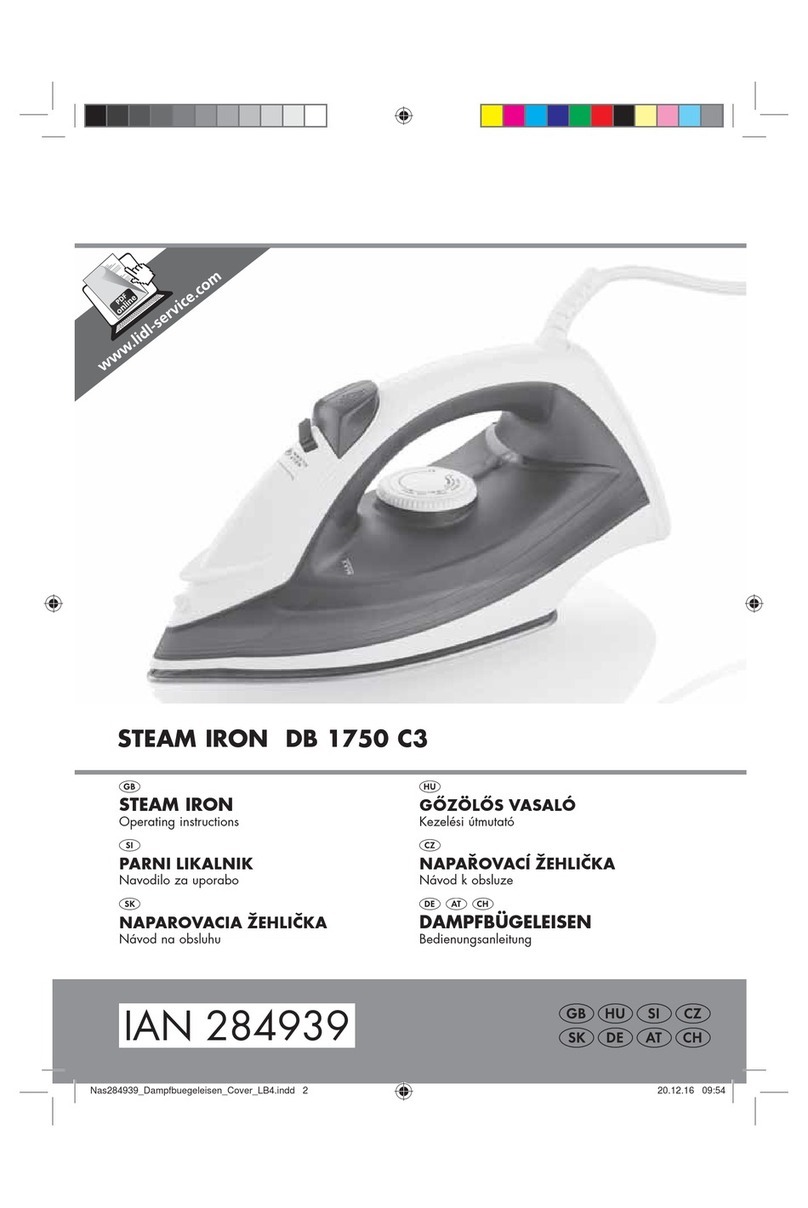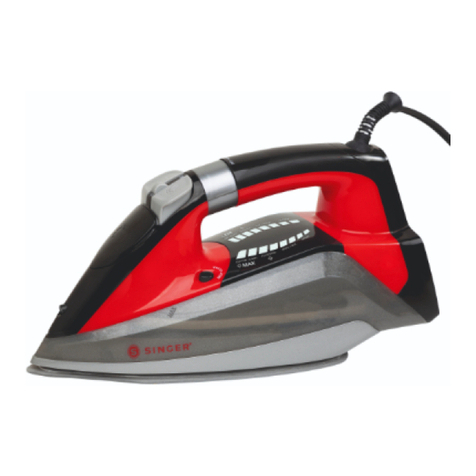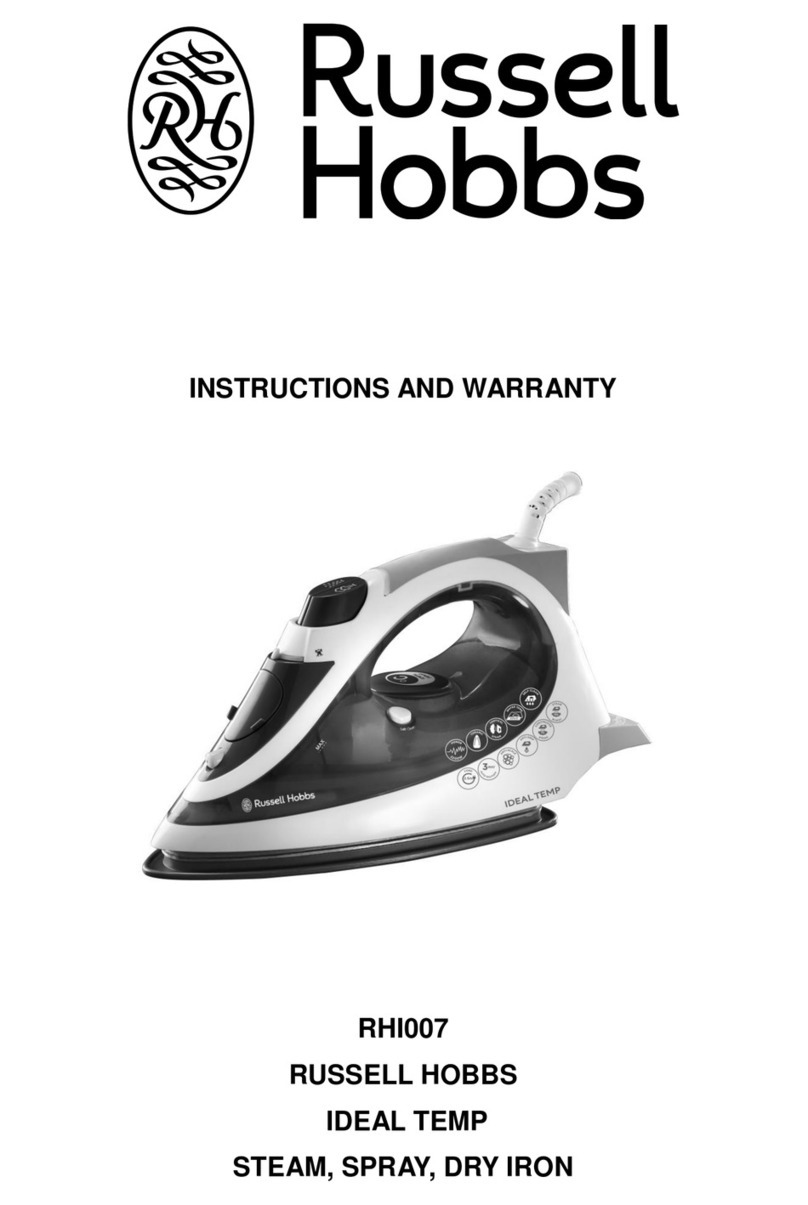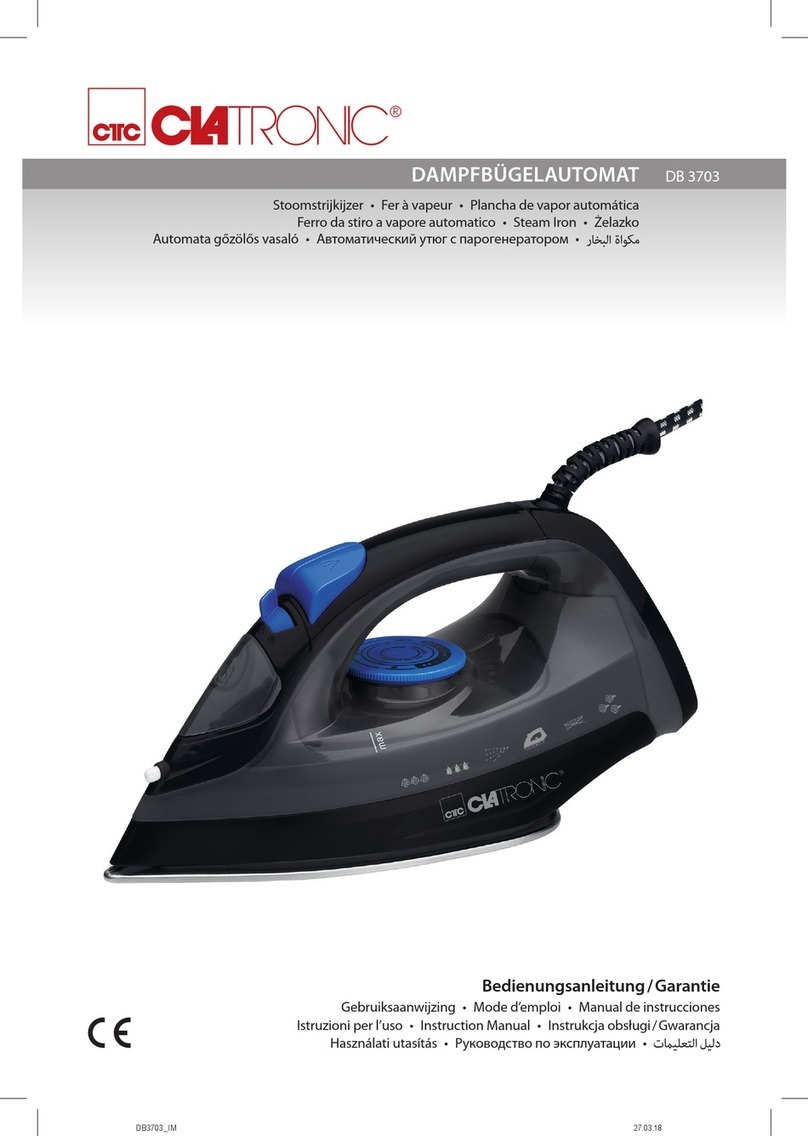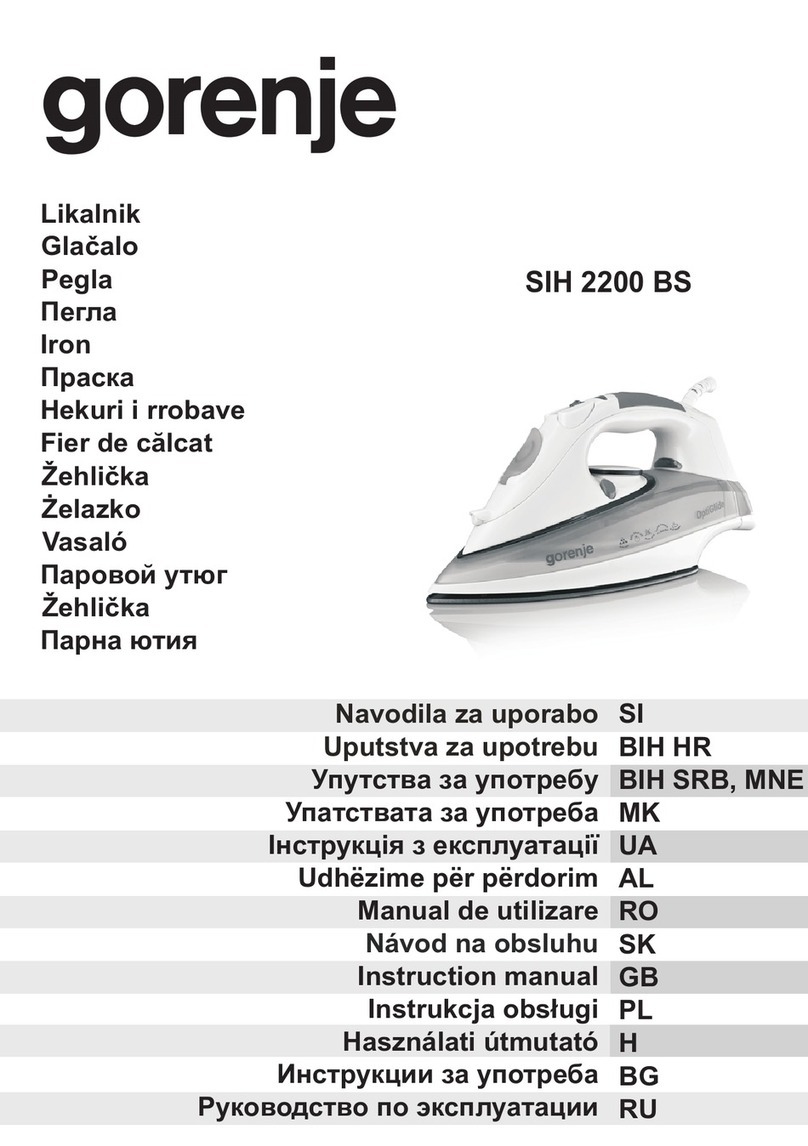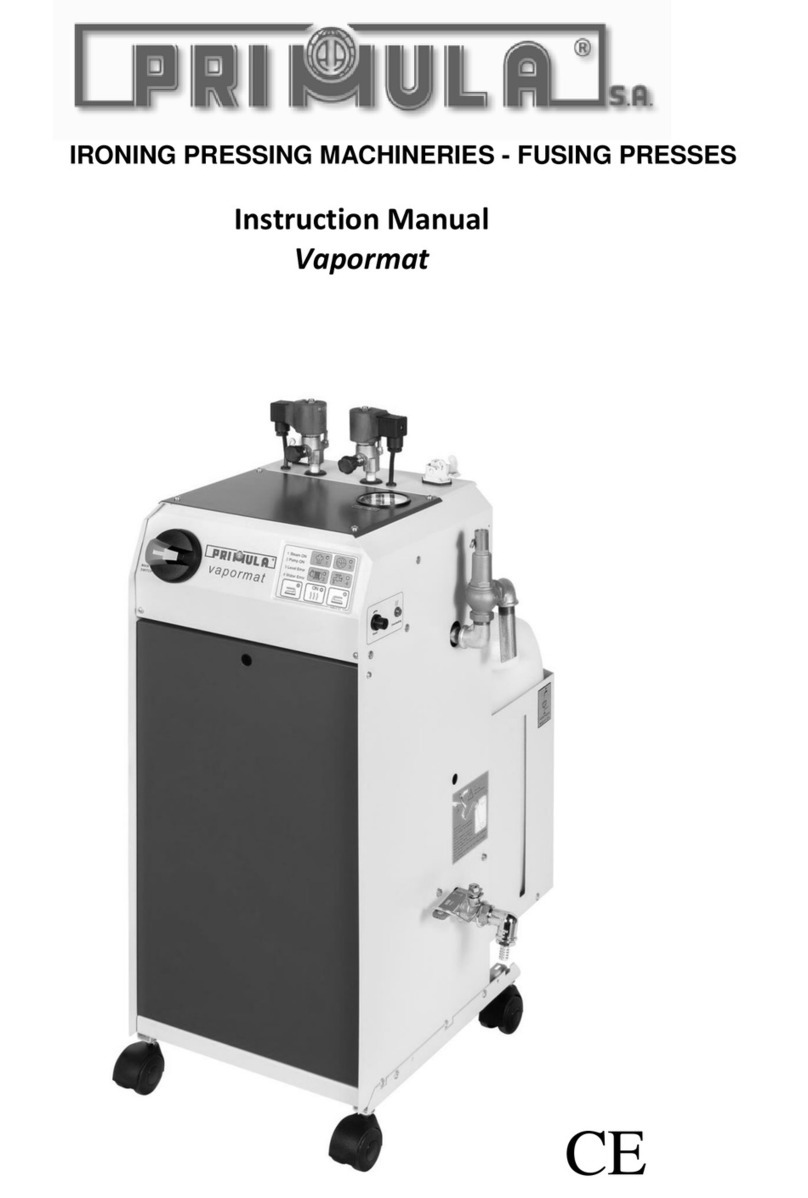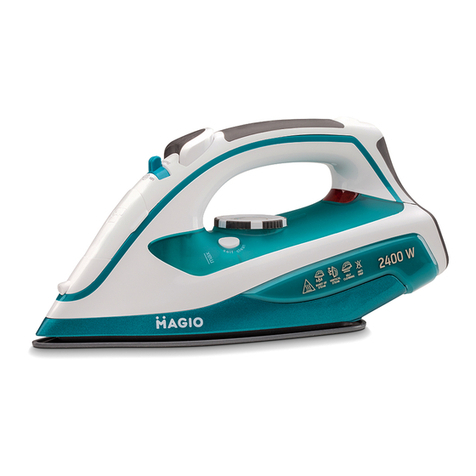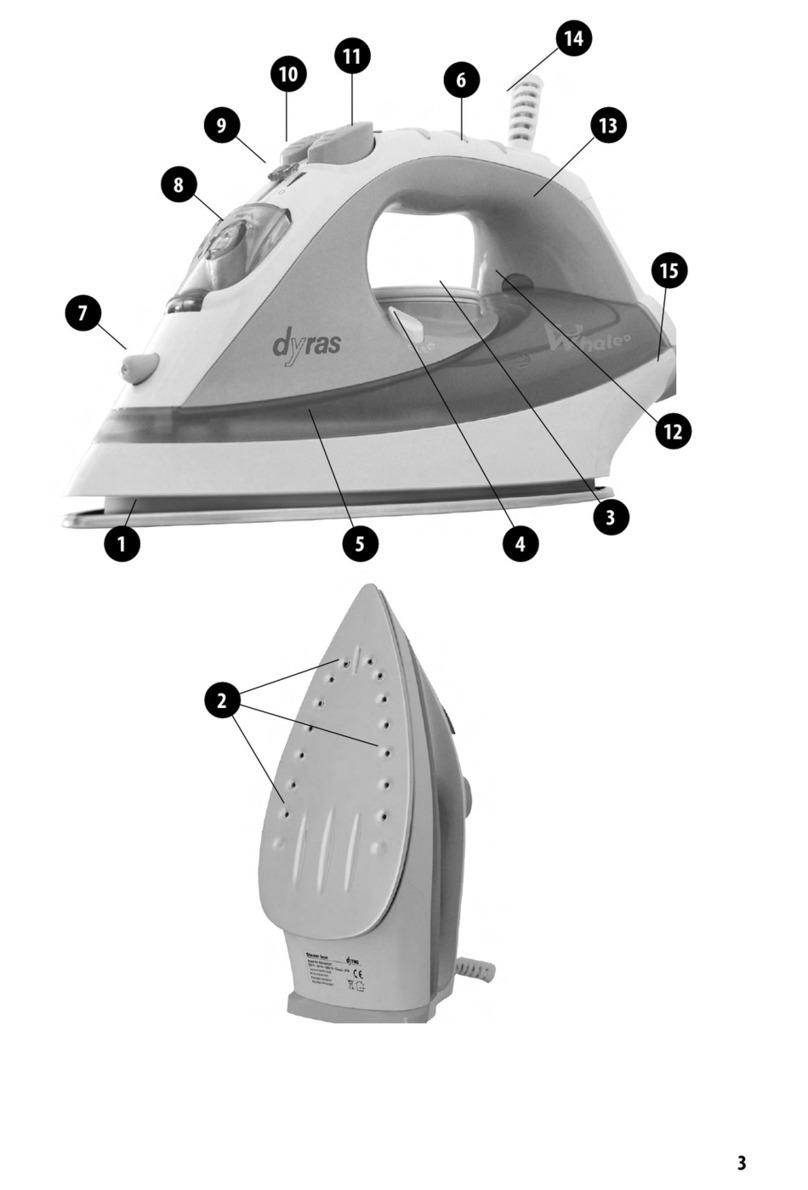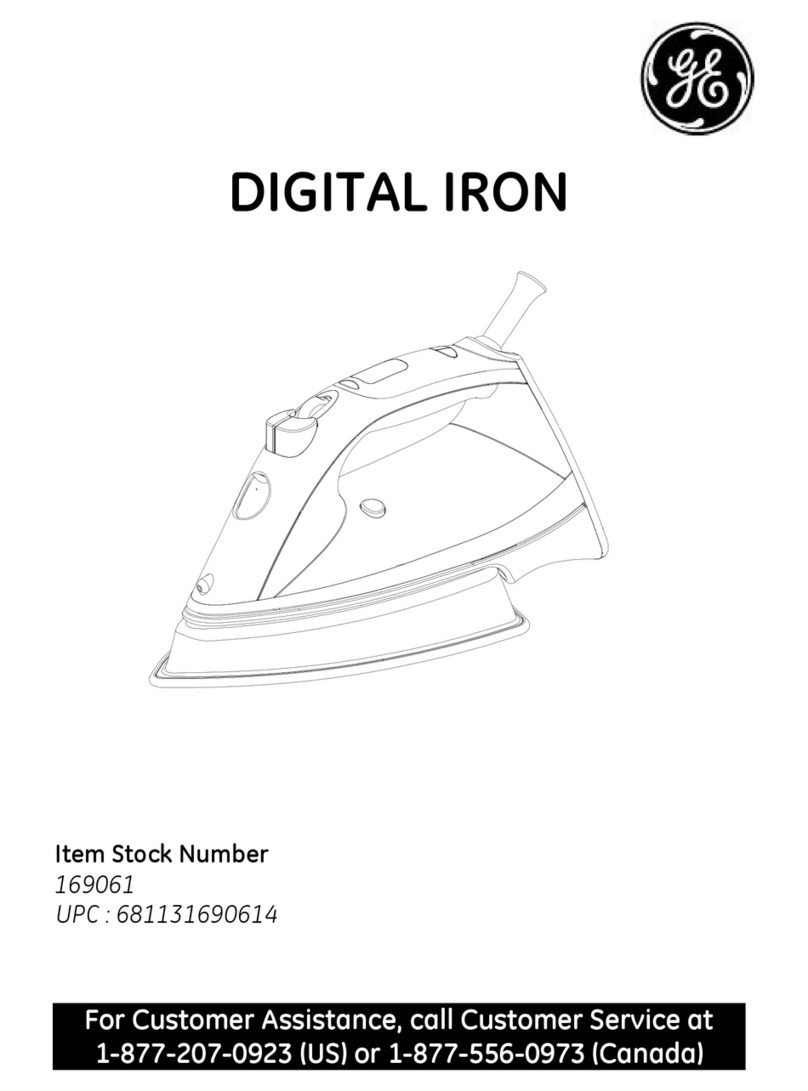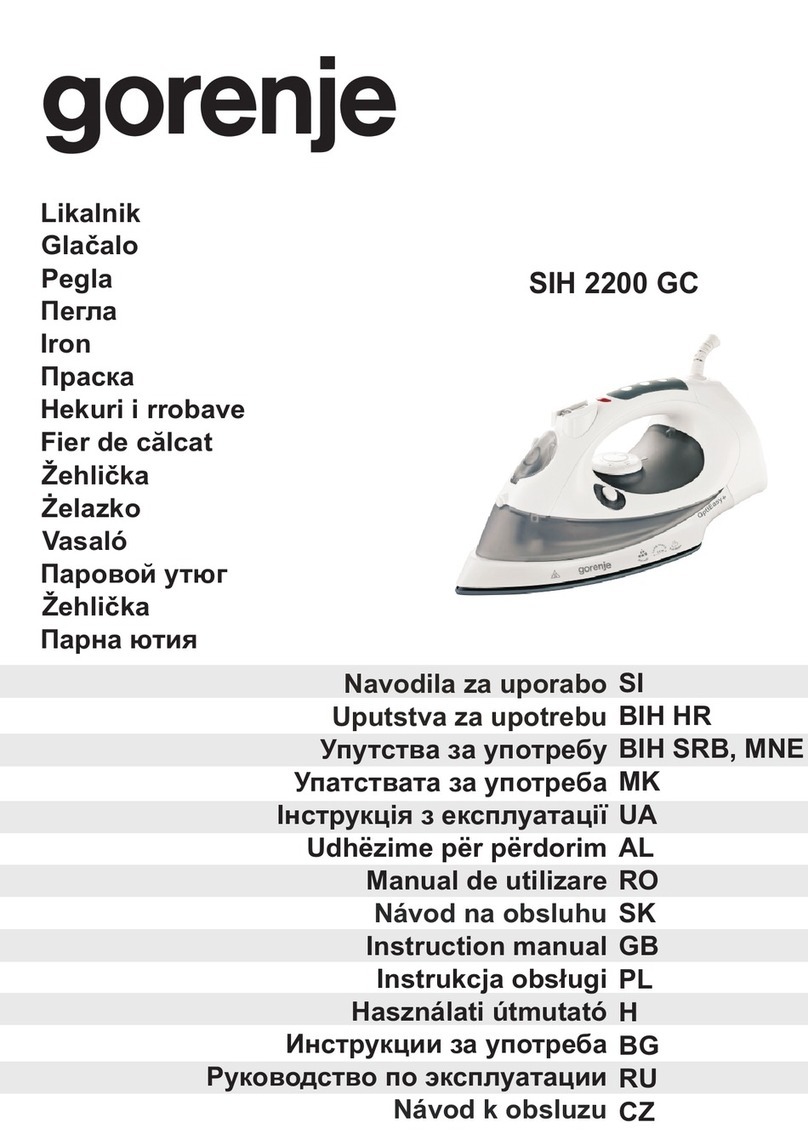ITALIANO
Congratulazioni per l’acquisto e benvenuti in Philips! Per trarre il massimo vantaggio
dall’assistenza Philips, registrate il vostro prodotto su www.philips.com/welcome.
Importante
Prima di utilizzare l’apparecchio, leggete attentamente il presente manuale utente e
conservatelo per eventuali riferimenti futuri.
Pericolo
Non immergete mai il ferro nell’acqua.
Prima di collegare l’apparecchio, controllate che la tensione indicata sulla
placchetta corrisponda a quella della rete locale.
Non utilizzate l’apparecchio nel caso in cui la spina, il cavo di alimentazione o
l’apparecchio stesso siano danneggiati o in presenza di rotture.
Nel caso in cui il cavo di alimentazione fosse danneggiato, dovrà essere sostituito
presso i centri autorizzati Philips, i rivenditori specializzati oppure da personale
debitamente qualicato, per evitare situazioni pericolose.
Non lasciate mai l’apparecchio incustodito quando è collegato alla presa di
corrente.
L’apparecchio non è destinato a persone (inclusi bambini) con capacità mentali,
siche o sensoriali ridotte, fatti salvi i casi in cui tali persone abbiano ricevuto
assistenza o formazione per l’uso dell’apparecchio da una persona responsabile
della loro sicurezza.
Adottate le dovute precauzioni per evitare che i bambini giochino con
l’apparecchio.
Evitate che il cavo di alimentazione venga a contatto con la piastra del ferro calda.
Collegate l’apparecchio esclusivamente a una presa di messa a terra.
Vericate periodicamente le condizioni del cavo di alimentazione.
Posizionate e utilizzate sempre il ferro su una supercie piana, stabile e
orizzontale.
La piastra del ferro può surriscaldarsi eccessivamente e provocare scottature se a
contatto con la pelle.
Dopo aver utilizzato l’apparecchio,durante le operazioni di pulizia o se lasciate
l’apparecchio incustodito anche per un breve periodo, mettete il ferro in
posizione verticale e scollegate la spina dalla presa a muro.
Questo apparecchio è destinato esclusivamente a uso domestico.
Questo apparecchio Philips è conforme a tutti gli standard relativi ai campi
elettromagnetici (EMF). Se utilizzato in modo appropriato seguendo le istruzioni
contenute nel presente manuale utente, l’apparecchio consente un utilizzo sicuro
come confermato dai risultati scientici attualmente disponibili.
1 Rimuovete gli eventuali adesivi o il foglio di protezione dalla piastra.
2 Riscaldate il ferro alla massima temperatura e passatelo su uno straccio umido
per vari minuti, per eliminare eventuali residui dalla piastra.
1 Ponete il ferro in posizione verticale.
2 Impostate la temperatura di stiratura desiderata ruotando il termostato sulla
posizioneappropriata(g.1).
Vericate sull’etichetta del capo la temperatura di stiratura richiesta:
1Tessuti sintetici (ad esempio acrilico, viscosa, poliammide, poliestere)
1Seta
2Lana
3Cotone, lino
Se non si conosce il tessuto del capo da stirare, si consiglia di stirare un angolo
nascosto per determinare la temperatura più indicata.
Seta, lana e bre sintetiche: stirate il capo a rovescio per evitare aloni lucidi.
Iniziate a stirare i capi che richiedono una temperatura di stiratura più bassa, ad
esempio i tessuti sintetici.
3 Inserite la spina in una presa di messa a terra.
Stiratura
Nota La prima volta che si utilizza il ferro, si potrebbe notare la fuoriuscita di vapore;
tuttavia scompare dopo poco tempo.
1 Impostate la temperatura di stiratura consigliata (si veda più avanti la sezione
“Impostazione della temperatura”).
2 Soloalcunimodelli:lasciateriscaldareilferroperdueminuti.
Se regolate il termostato su una impostazione inferiore dopo aver stirato a una
temperatura più alta, è necessario lasciare raffreddare il ferro da stiro per cinque
minuti prima di continuare la stiratura.
3 Soloalcunimodelli:lasciateriscaldareilferronchélaspiadellatemperatura
nonsispegneepoisiriaccende(g.2).
Nota Durante la stiratura, la spia della temperatura si accende regolarmente.
4 Iniziate a stirare.
1 Togliete la spina dalla presa e lasciate raffreddare il ferro.
2 Pulite la piastra con un panno umido e con un detergente (liquido) non
abrasivo.
Per mantenere la piastra perfettamente liscia,evitate il contatto con oggetti
metallici. Per pulire la piastra,non utilizzate pagliette, aceto o altre sostanze
chimiche.
3 Per pulire la parte superiore del ferro utilizzate un panno umido.
1 Scollegate la spina dalla presa a muro.
2 Avvolgeteilcavoattornoall’appositosupporto(g.3).
3 Riponete il ferro in posizione verticale, in un ambiente sicuro e asciutto.
Per contribuire alla tutela dell’ambiente, non smaltite l’apparecchio con i normali i
riuti domestici, ma consegnatelo a un centro di raccolta autorizzato (g. 4).
Se avete bisogno di assistenza o informazioni o in caso di problemi, visitate il sitoWeb
Philips all’indirizzo www.philips.com oppure contattate il Centro Assistenza Clienti
Philips del vostro Paese (per conoscere il numero di telefono consultate l’opuscolo
della garanzia). Se nel vostro Paese non esiste un Centro Assistenza Clienti, rivolgetevi
al vostro rivenditore Philips.
In questo capitolo vengono riportati i problemi più ricorrenti legati all’uso
dell’apparecchio. Se non riuscite a risolvere i problemi con le informazioni seguenti, vi
preghiamo di contattare il Centro Assistenza Clienti Philips del vostro paese.
Problema Possibile causa Soluzione
Il ferro è collegato
alla presa di
corrente ma la
piastra è fredda.
Si è vericato
un problema di
alimentazione.
Vericate il cavo di alimentazione,
lo spinotto e la presa a muro.
Il termostato è
impostato su MIN. Impostate il termostato sulla
posizione richiesta.
-
-
-
-
-
-
-
-
-
-
-
-
-
-
-
-
-
-
-
Inleiding
Gefeliciteerd met uw aankoop en welkom bij Philips! Als u volledig wilt proteren
van de ondersteuning die Philips biedt, registreer uw product dan op www.philips.
com/welcome.
Belangrijk
Lees deze gebruiksaanwijzing zorgvuldig door voordat u het apparaat gaat gebruiken.
Bewaar de gebruiksaanwijzing om deze indien nodig te kunnen raadplegen.
Gevaar
Dompel het strijkijzer nooit in water.
Controleer of het voltage aangegeven op het typeplaatje overeenkomt met de
plaatselijke netspanning voordat u het apparaat aansluit.
Gebruik het apparaat niet indien de stekker, het netsnoer of het apparaat zelf
zichtbaar beschadigd is. Gebruik het apparaat ook niet meer als het is gevallen.
Indien het netsnoer beschadigd is, moet u het laten vervangen door Philips,
een door Philips geautoriseerd servicecentrum of personen met vergelijkbare
kwalicaties om gevaar te voorkomen.
Laat het apparaat nooit onbeheerd achter terwijl het op netspanning is
aangesloten.
Dit apparaat is niet bedoeld voor gebruik door personen (waaronder kinderen)
met verminderde lichamelijke, zintuiglijke of geestelijke vermogens, of die gebrek
aan ervaring of kennis hebben, tenzij iemand die verantwoordelijk is voor hun
veiligheid toezicht op hen houdt of hen heeft uitgelegd hoe het apparaat dient te
worden gebruikt.
Houd toezicht op kinderen om te voorkomen dat ze met het apparaat gaan
spelen.
Voorkom dat het netsnoer in aanraking komt met de hete zoolplaat van het
strijkijzer.
Let op
Sluit het apparaat alleen aan op een geaard stopcontact.
Controleer regelmatig of het netsnoer niet beschadigd is.
Plaats en gebruik het strijkijzer altijd op een stabiele, vlakke en horizontale
ondergrond.
De zoolplaat van het strijkijzer kan zeer heet worden en bij aanraking
brandwonden veroorzaken.
Als u klaar bent met strijken, als u het strijkijzer schoonmaakt en als u bij het
strijkijzer wegloopt (als is het maar even), zet dan het strijkijzer op de achterkant
en haal de stekker uit het stopcontact.
Het apparaat is uitsluitend bedoeld voor huishoudelijk gebruik.
Dit Philips-apparaat voldoet aan alle richtlijnen met betrekking tot elektromagnetische
velden (EMV). Mits het apparaat op de juiste wijze en volgens de instructies in
deze gebruiksaanwijzing wordt gebruikt, is het veilig te gebruiken volgens het nu
beschikbare wetenschappelijke bewijs.
1 Verwijder eventuele stickers of beschermfolie van de zoolplaat.
2 Laat het strijkijzer opwarmen tot de maximumtemperatuur en beweeg het
strijkijzer vervolgens gedurende een paar minuten over een vochtige doek om
mogelijke resten van de zoolplaat te verwijderen.
Het apparaat gebruiken
1 Zet het strijkijzer op zijn achterkant.
2 Stel de vereiste strijktemperatuur in door de temperatuurregelaar naar de
juistestandtedraaien(g.1).
Raadpleeg het wasetiket van het te strijken artikel voor de juiste strijktemperatuur:
1Synthetische stoffen (bijv. acryl, viscose, polyamide, polyester)
1Zijde
2Wol
3Katoen, linnen
Als u niet zeker weet van welk materiaal het artikel gemaakt is, probeer de gekozen
strijktemperatuur dan eerst uit op een plek die niet zichtbaar is wanneer u het artikel
draagt of gebruikt.
Zijde, wol en synthetische materialen: strijk de binnenkant van de stoffen om
glimmende plekken te voorkomen.
Strijk eerst de ar tikelen die op de laagste temperatuur gestreken moeten worden,
zoals artikelen gemaakt van synthetische stoffen.
3 Steek de stekker in een geaard stopcontact.
Strijken
Opmerking: Er kan wat rook uit het strijkijzer komen wanneer u het voor de eerste keer
gebruikt. Dit houdt na korte tijd op.
1 Stel de aanbevolen strijktemperatuur in (zie ‘De temperatuur instellen’
hierboven).
2 Alleenbepaaldetypen:laathetstrijkijzertweeminutenopwarmen.
Als u na het strijken op een hoge temperatuur de temperatuurregelaar instelt op een
lagere stand, laat het strijkijzer dan vijf minuten afkoelen voordat u verdergaat met
strijken.
3 Alleenbepaaldetypen:laathetstrijkijzeropwarmentothet
temperatuurlampjeuitgaatenvervolgensweergaatbranden(g.2).
Opmerking: Het temperatuurlampje gaat tijdens het strijken af en toe aan.
4 Begin met strijken.
1 Haal de stekker uit het stopcontact en laat het strijkijzer afkoelen.
2 Veeg de zoolplaat schoon met een vochtige doek en een niet-schurend
(vloeibaar) schoonmaakmiddel.
Houd de zoolplaat glad door te voorkomen dat deze hard in aanraking komt met
metalen voorwerpen. Gebruik nooit een schuurspons, azijn of andere chemicaliën
om de zoolplaat te reinigen.
3 Maak de bovenkant van het strijkijzer schoon met een vochtige doek.
Opbergen
1 Haal de stekker uit het stopcontact.
2 Windhetsnoerronddesnoerhaspel(g.3).
3 Berg het strijkijzer op door het op zijn achterkant op een veilige en droge
plaats neer te zetten.
Gooi het apparaat aan het einde van zijn levensduur niet weg met het normale
huisvuil, maar lever het in op een door de overheid aangewezen inzamelpunt
om het te laten recyclen. Op die manier levert u een bijdrage aan een schonere
leefomgeving (g. 4).
Als u service of informatie nodig hebt of als u een probleem hebt, bezoek dan de
Philips-website (www.philips.nl), of neem contact op met het Philips Consumer
Care Centre in uw land (u vindt het telefoonnummer in het ‘worldwide guarantee’-
vouwblad).Als er geen Consumer Care Centre in uw land is, ga dan naar uw Philips-
dealer.
Dit hoofdstuk behandelt in het kort de problemen die u kunt tegenkomen tijdens
het gebruik van het apparaat. Als u er niet in slaagt het probleem op te lossen met
behulp van de onderstaande informatie, neem dan contact op met het Consumer
Care Centre in uw land.
Probleem Mogelijke oorzaak Oplossing
De stekker zit in
het stopcontact,
maar de zoolplaat
is koud.
Er is een
aansluitprobleem. Controleer het netsnoer, de
stekker en het stopcontact.
De temperatuurregelaar
staat op MIN. Stel de temperatuurregelaar in
op de vereiste strijktemperatuur.
-
-
-
-
-
-
-
-
-
-
-
-
-
-
-
-
-
-
-
Introdução
Parabéns pela sua compra e bem-vindo(a) à Philips! Para poder beneciar de todas as
vantagens da assistência Philips, registe o seu produto em www.philips.com/welcome.
Importante
Leia cuidadosamente este manual do utilizador antes de utilizar o aparelho e guarde-
o para uma eventual consulta futura.
Perigo
Nunca mergulhe o ferro dentro de água.
Verique se a voltagem indicada na sinalética corresponde à voltagem eléctrica
local, antes de ligar o aparelho.
Não utilize o aparelho se a cha, o o ou o próprio aparelho apresentarem sinais
visíveis de danos ou se tiver deixado cair o aparelho.
Se o o estiver danicado, deve ser sempre substituído pela Philips, por um
centro de assistência autorizado da Philips ou por pessoal devidamente
qualicado para se evitarem situações de perigo.
Nunca deixe o aparelho sozinho quando estiver ligado à corrente.
Este aparelho não deve ser utilizado por pessoas (incluindo crianças) com
capacidades físicas, sensoriais ou mentais reduzidas, ou com falta de experiência
e conhecimento, a não ser que lhes tenha sido dada supervisão ou instruções
relativas à utilização do aparelho por uma pessoa responsável pela sua segurança.
As crianças devem ser vigiadas para assegurar que não brincam com o aparelho.
Não deixe que o o de alimentação entre em contacto com a base quente do
ferro.
Atenção
Ligue sempre o aparelho a uma tomada com terra.
Verique regularmente se o o de alimentação se encontra danicado.
Coloque e utilize sempre o ferro sobre uma superfície estável, plana e horizontal.
A base do ferro pode car extremamente quente e causar queimaduras se for
tocada.
Quando terminar de passar,quando limpar o aparelho e também quando
abandonar o ferro mesmo por pouco tempo: coloque o ferro em posição de
descanso e retire a cha de alimentação da tomada eléctrica.
Este aparelho destina-se apenas a utilização doméstica.
Este aparelho Philips cumpre todas as normas relacionadas com campos
electromagnéticos (EMF). Se for manuseado correctamente e de acordo com as
instruções presentes no manual do utilizador, o aparelho proporciona uma utilização
segura, como demonstrado pelas provas cientícas actualmente disponíveis.
1 Retire todos os autocolantes ou película de protecção da base do ferro.
2 Deixe o ferro aquecer até à temperatura máxima e passe-o sobre um pedaço
de pano húmido durante alguns minutos para remover todos os resíduos da
base.
1 Coloque o ferro em posição de descanso.
2 Para regular o ferro para a temperatura pretendida, rode o botão da
temperaturaparaaposiçãoapropriada(g.1).
Verique a etiqueta da peça de roupa para saber qual a temperatura que deve
seleccionar:
1Tecidos sintéticos (p. ex.: acrílico, viscose, poliamida, poliéster)
1Seda
2Lã
3Algodão, linho
Se desconhecer o tipo ou os tipos de material da peça, calcule a temperatura certa
experimentando primeiro numa parte que não que à vista quando vestir ou usar a
roupa.
Seda, lã e tecidos sintéticos: passe o tecido pelo lado do avesso para evitar a
formação de lustro.
Comece por passar as peças que necessitem de temperatura mais baixa, como é o
caso das bras sintéticas.
3 Ligueachaaumatomadacomterra.
Nota: O ferro pode libertar algum fumo quando for utilizado pela primeira vez. É normal
e pára passado pouco tempo.
1 Seleccione a temperatura pretendida (consulte a secção ‘Selecção da
temperatura’ em baixo).
2 Apenastiposespecícos:permitaqueoferrodeengomaraqueçadurantedois
minutos.
Se colocar o botão de temperatura numa regulação inferior depois de engomar a
uma alta temperatura, permita que o ferro arrefeça durante cinco minutos antes de
continuar a engomar.
3 Apenastiposespecícos:permitaqueoferroaqueçaatéquealuzde
temperaturaseapagueeacendanovamente(g.2).
Nota: A luz da temperatura acende-se ocasionalmente enquanto passa a ferro.
4 Comece a passar a ferro.
1 Retireachadatomadaeléctricaedeixeoferroarrefecer.
2 Limpe a base com um pano húmido e agente de limpeza (líquido) não abrasivo.
Para conservar a base do ferro macia, deve evitar o contacto com objectos
metálicos. Nunca utilize esfregões, vinagre ou produtos químicos para limpar a base
do ferro.
3 Limpe a parte de cima do ferro com um pano húmido.
Arrumação
1 Retireachaeléctricadatomada.
2 Enroleoodoferronocompartimentopróprio(g.3).
3 Arrume o ferro na posição de descanso, num local seguro e seco.
Ambiente
Não deite fora o aparelho com o lixo doméstico normal no nal da sua vida
útil; entregue-o num ponto de recolha ocial para reciclagem. Ao fazê-lo, ajuda a
preservar o ambiente (g. 4).
Se necessitar de reparações, informações ou se tiver problemas, visite o Web site
da Philips em www.philips.pt ou contacte o Centro de Assistência ao Consumidor
local (pode encontrar o número de telefone no folheto de garantia mundial). Se não
existir um Centro de Assistência no seu país,visite o seu representante Philips local.
Este capítulo resume alguns dos problemas mais comuns que pode encontrar no
aparelho. Se não conseguir resolver o problema através das indicações dadas a seguir,
contacte o Centro de Atendimento ao Cliente Philips no seu país.
Problema Causa provável Solução
O ferro está
ligado mas a base
continua fria.
Ocorreu um problema
com a ligação. Verique o cabo de alimentação
eléctrica, a cha e a tomada de
parede.
O botão de
temperatura está na
posição MIN.
Regule a temperatura para a
posição pretendida.
-
-
-
-
-
-
-
-
-
-
-
-
-
-
-
-
-
-
-
Chúc mừng bạn đã mua được sản phẩm Philips mới và chào mừng bạn đến với
Philips! Để có được lợi ích đầy đủ từ sự hỗ trợ do Philips cung cấp, hãy đăng ký sản
phẩm tại www.philips.com/welcome.
Hãy đọc kỹ hướng dẫn sử dụng này trước khi sử dụng thiết bị và cất giữ để tiện tham
khảo sau này.
Không được nhúng bàn ủi trong nước.
Trước khi cm điện, kiểm tra xem điện p ghi trên bàn ủi có tương ng với hiệu
điện thế ngun hay không.
Không sử dụng thiết bị này nếu phích cm, dây điện hoặc chính bản thân thiết bị
có biểu hiện hư hỏng biểu hiện ra bên ngoài, hoặc nếu bàn ủi đã bị rơi.
Nếu dây điện bị hư hỏng, bạn nên thay dây điện tại trung tâm bảo hành của
Philips, trung tâm bảo hành do Philips ủy quyn hoặc những nơi có khả năng và
trnh đ tương đương để trnh gây nguy hiểm.
Phải luôn để mt đến thiết bị khi đã cm điện.
Thiết bị này không dành cho ngưi dùng (bao gm cả trẻ em) có sc khỏe kém,
khả năng gic quan hoặc có dấu hiệu tâm thần, hoặc thiếu kinh nghiệm và kiến
thc, trừ khi họ được gim st hoặc hướng dẫn sử dụng thiết bị bởi ngưi có
trch nhiệm đảm bảo an toàn cho họ.
Trẻ em phải được gim st để đảm bảo rng chúng không chơi đùa với thiết bị
này.
Không để dây điện ngun tiếp xúc với mặt đế bàn ủi khi còn nóng.
Ch ni lò chiên vào cm điện có dây tiếp đất.
Kiểm tra dây điện ngun thưng xuyên v những hư hỏng có thể xảy ra.
Luôn đặt và sử dụng bàn ủi trên b mặt phẳng, nm ngang và chc chn.
Mặt bàn ủi rất nóng và có thể gây bỏng nếu chạm vào.
Khi ủi xong, khi lau chùi và cả khi không ủi thậm chí ch trong chc lt: dựng đng
bàn ủi và rút phích cm ra khỏi điện.
Thiết bị này được thiết kế ch để dùng trong gia đnh.
Thiết bị Philips này tuân thủ tất cả cc tiêu chuẩn liên quan đến cc từ trưng điện
(EMF). Nếu được sử dụng đúng và tuân thủ cc hướng dẫn trong sch hướng dẫn này,
theo cc bng chng khoa học hiện nay, việc sử dụng thiết bị này là an toàn.
1 Loibttccnhnhoclpbovdnhtrênmtđbni.
2 Đbninnglênđnnhitđtiđavlbnitrênmtmingvim
trongviphtđloibnhngcubnkhimtđbni.
1 Dngđngbni
2 Đchnnhitđiyêucu,xoaynmđiuchnhnhitđđnvtrtương
ng(Hnh1).
Kiểm tra nhãn ghi chất liệu vải để biết nhiệt đ ủi yêu cầu:
1 Vải tng hợp (ví dụ: acrylic, sợi vitcô, polyamit, vải pôliexte)
1 Tơ lụa
2 Len
3 Bông, lanh
Nếu bạn không biết mt món đ được làm bng (những) loại vải nào, hãy chọn nhiệt
đ ủi thích hợp bng cch ủi thử mt vùng không bị nhn thấy khi bạn mặc vào hoặc
sử dụng món đ đó.
Đi với vải tơ lụa, vải len và vải tng hợp: hãy ủi mặt tri để vải không bị bóng.
Hãy ủi trước cc loại quần o thích hợp với nhiệt đ ủi thấp nhất, ví dụ như cc loại
quần o làm từ sợi tng hợp.
3 Cmđinvocmctipđt.
Lưu ý: Khi s dng ln đu tiên, bn i s thi ra mt t khi. Hin tưng ny s kt thc
sau mt lc s dng.
1 Chnnhitđinhưđượcđxut(xemmục‘Điuchnhnhitđ’ởtrên).
2 Chcởmtskiunhtđnh:Đbninnglêntronghaipht.
Nếu bạn điu chnh nhiệt đ sang mt mc thấp hơn sau khi ủi ở mt nhiệt đ cao,
hãy để cho bàn ủi ngui đi bớt trong năm phút trước khi bạn bt đầu ủi lại.
3 Chcởmtskiunhtđnh:hyđbninnglênchotikhiđènbo
nhitđttvsauđsngtrởli(Hnh2).
Lưu ý: Đn bo nhit đ s thnh thong bt sng trong khi i.
4 Btđui.
1 Rtdâycmbnirakhiđinvđbninguiđi.
2 Lauschmtđbnibngmtmingvimvimtchtlmschkhông
ănmn(dnglng).
Đgichomtbniđượctrơnnhn,bnnêntrnhđvachmmnhvicc
đvtbngkimloi.Khôngbaogidngccmingxpcra,gimhocccho
chtkhcđlmschmtbni.
3 Lauchiphntrêncabnibngmtmingvim.
1 Rtphchcmbnirakhicmđin.
2 Qundâyđinvngquanhchânđ(Hnh3).
3 Đtbniđngđboqunvđtởmtnơikhôroanton.
Không vt thiết bị cùng chung với rc thải gia đnh thông thưng khi ngừng sử
dụng nó mà hãy đem thiết bị đến điểm thu gom chính thc để ti chế. Làm như
vậy sẽ giúp bảo vệ môi trưng (Hnh 4).
Nếu bạn cần biết dịch vụ, thông tin hay gặp trục trặc, vui lòng vào website của Philips
tại www.philips.com hoặc liên hệ với Trung Tâm Chăm Sóc Khch Hàng của Philips ở
nước bạn (bạn sẽ tm thấy s điện thoại của Trung tâm trong t bảo hành khp thế
giới). Nếu không có Trung Tâm Chăm Sóc Khch Hàng tại quc gia của bạn, hãy liên
hệ với đại lý Philips tại địa phương bạn.
Chương này tóm tt cc sự c thưng gặp phải với thiết bị này. Nếu bạn không thể
giải quyết được vấn đ sau khi tham khảo thông tin dưới đây, hãy liên hệ với Trung
Tâm Chăm Sóc Khch Hàng của Philips tại nước bạn.
Vấn đ Nguyên nhân có thể Giải php
Bàn ủi đã được cm
điện nhưng mặt bàn ủi
không nóng.
Có vấn đ v dây ni hay
phích cm điện.
Kiểm tra dây điện, phích
cm và cm.
Núm điu chnh nhiệt đ
được đặt ở vị trí MIN (ti
thiểu).
Vặn nút điu chnh nhiệt
đ tới vị trí yêu cầu.
-
-
-
-
-
-
-
-
-
-
-
-
-
-
-
-
-
-
-




